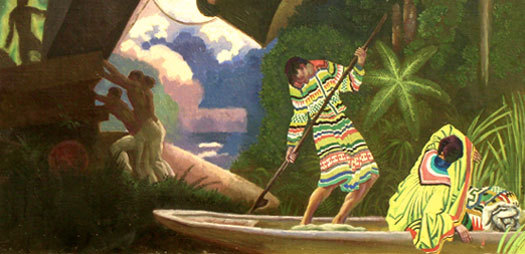
Detail from Orchid Hunters (1935) by Eugene Francis Savage. Savage favored a palette of greenish hues, a feature his students went to great lengths to emulate
A century ago, art and design juries often favored the same participants, year after year, a corruption of power that was anything but fair. Especially when jurors favored applicants made in their own image.
Eugene Savage, an American muralist who was a professor of painting at Yale School of Art in the 1920s, served on the jury for the American Academy in Rome for a number of years — (as did Ezra Winter, who was also a muralist and like Savage, was a fellow at the Academy in 1915). Described as "bristle-lipped" by Time Magazine, Savage managed to successfully admit so many Yale School of Art hopefuls that they became known as "The Little Savages", and not only because they were Elis. It turns out that those who were most successful were the ones who most dutifully aped their master's style.
In the interests of full disclosure, I received my MFA from Yale School of Art and have been on the faculty there for well over a decade, and last spring, I was the Henry Wolf resident in graphic design at the Academy. In addition to our differences in gender and generation, suffice it to say that Savage's experience and mine could not have been more different.
Those of us who sit on juries and are even, on occasion, the fortunate beneficiaries of jury-elected awards, do so with the full knowledge that we share in a time-honored tradition of fairness, but clearly, this has not always been the case. Stories like Savage's read as especially vexing if you stop and think about what a simple thing like term limits can do to ensure fairness. How strange it is today to think that Savage's proteges were rewarded for their impeccable plagiarisms, or that Savage was praised for his part in encouraging such unforgivable behavior. There is a great deal to be said about the implicit ethical wrongs here, especially because leading by example — and by conjecture, learning by imitation – has always played such a precarious role in the creative classroom. The complicity on both sides is equally troubling: what kind of teacher would reward copycat performance, and what kind of student would engage in it?
